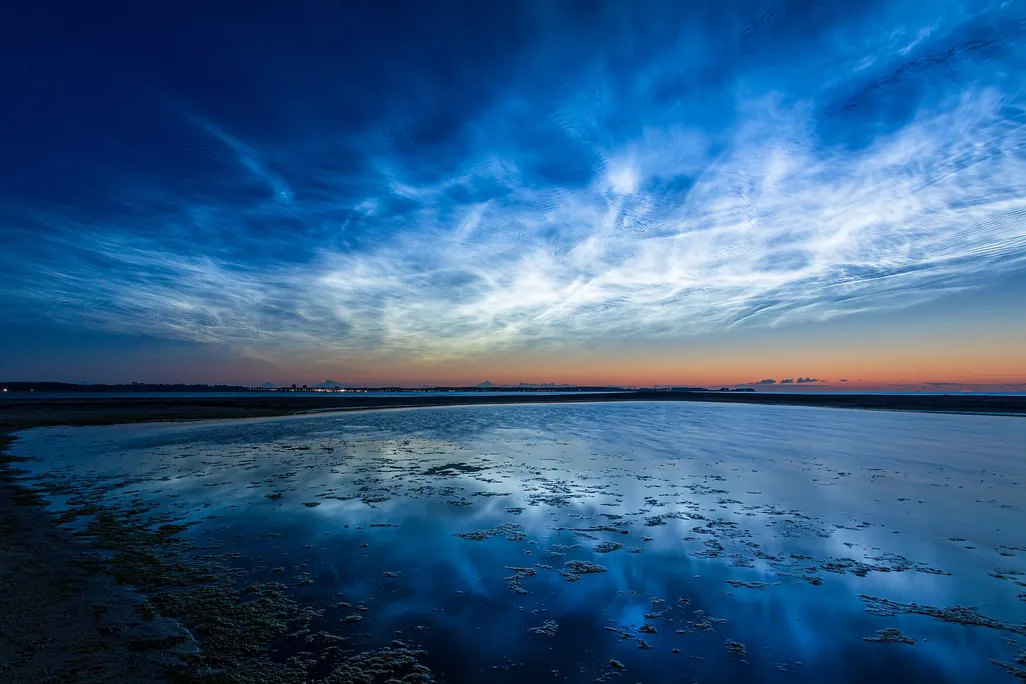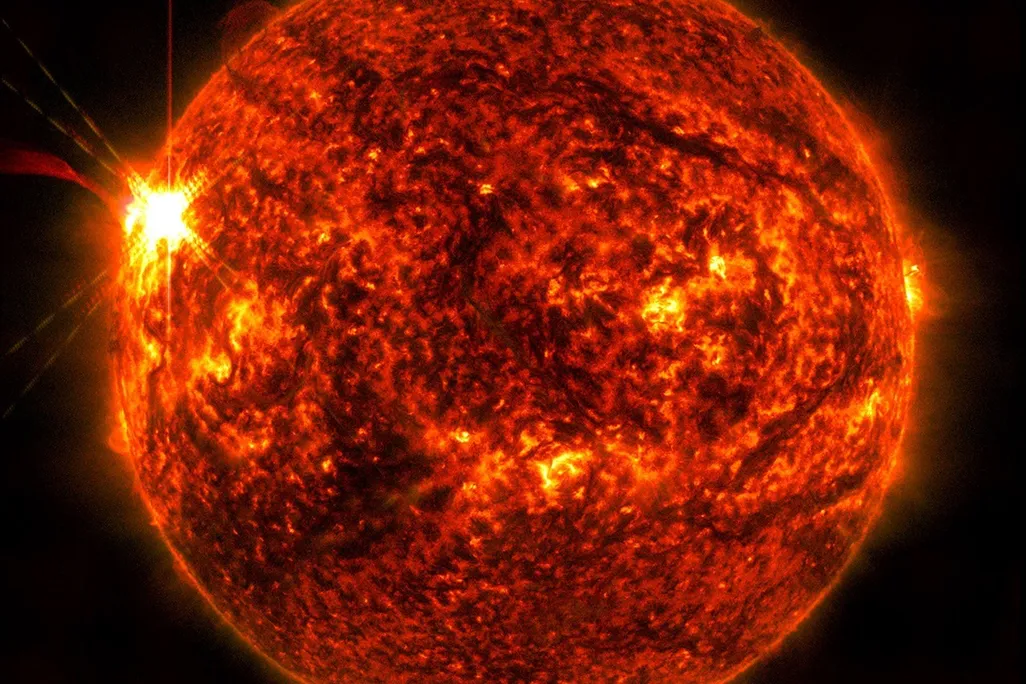NASA Wants Your Help to Study These Rare, High-Altitude Clouds That Appear to Glow at Sunrise and Sunset
NASA Wants Your Help to Study These Rare, High-Altitude Clouds That Appear to Glow at Sunrise and Sunset
Noctilucent clouds usually form close to the poles, but in recent decades, they’re being spotted closer to the Equator
Noctilucent clouds over the Baltic Sea, as seen from Germany in 2019. Typically seen in polar regions, the clouds are increasingly appearing at mid- and low latitudes.
Matthias Süßen via Wikimedia Commons under CC BY-SA 4.0
While astronomy and clouds don’t usually mix, a rare type of atmospheric phenomenon, called noctilucent or night-shining clouds, offers an exception, as reported by Space.com’s Anthony Wood.
Noctilucent clouds are wispy, silvery-blue clouds found at much higher altitudes than usual. While most clouds form in the troposphere between Earth’s surface and about 11 miles above the ground, these appear in the mesosphere, up to 50 miles high. They become visible right after sunset or right before sunrise, when the sun illuminates them from beyond the horizon. The rare clouds likely come into being as ice crystallizes on meteor dust, when the mesosphere is rich with water and very cold, per EarthSky.
Paradoxically, noctilucent clouds usually form in the summer. That’s because during the hottest months of the year, surface air warms up and rises, expanding and cooling as it does so. Alongside other processes, this cools the mesosphere to temperatures as low as minus 210 degrees Fahrenheit, according to EarthSky. This happens around Earth’s poles, so people are thus most likely to see noctilucent clouds in polar regions during the summer—for the Northern Hemisphere, the clouds tend to appear between late May and mid-August.
What are noctilucent clouds and how can you see them?
Watch on
More recently, however, the rare phenomenon has been spotted closer and closer to the Equator. As such, NASA published a statement earlier this month asking citizen scientists to submit their observations and photographs of noctilucent clouds—even pictures taken in the past—to a crowdsourced research project called Space Cloud Watch.
“Combined with satellite data and model simulations, your data can help us figure out why these noctilucent clouds are more frequently appearing at mid-low latitudes,” the agency explains.
According to Royal Museums Greenwich, some scholars suggest climate change is responsible for that shift, as well as rocket launches. Rocket exhaust trails consist of small ice particles and water vapor, which can contribute to noctilucent clouds once they reach the mesosphere.
Last summer, Europe saw especially spectacular noctilucent clouds, despite the fact that strong solar activity—such as what we’re experiencing now at the solar maximum—would normally have dissipated them, as reported by Spaceweather.com. This might be partially explained by the underwater volcano near Tonga that erupted in 2022 and threw a plume of water vapor into the atmosphere.
“That was two years ago, but it takes about two years for the vapor to circulate up to the mesosphere, where NLCsform. Water is a key ingredient for NLCs, so Tonga’s moisture could be turbocharging the clouds,” Spaceweather.com reported in June 2024, adding that the 124 rocket launches so far that year likely also played a role.
If you’re hoping to spot the night-shining clouds yourself this summer, the good news is that they’re visible to the naked eye. The bad news is that the only ways to predict their natural appearance are by checking for ideal upper atmospheric conditions and keeping an eye on north-facing webcams in regions east of your location, as reported by Stuart Atkinson for BBC Sky at Night Magazine last year. If noctilucent clouds are forming in those eastern skies, where the sun sets earlier, chances are that they might be soon visible in your area.
And if you do happen to catch a glimpse, don’t forget to snap a photo for science. “I find these clouds fascinating and can’t wait to see the amazing pictures,” Space Cloud Watch project lead Chihoko Cullens, a research scientist at the University of Colorado, Boulder, says in NASA’s statement.
Get the latest stories in your inbox every weekday.
#nasa #wants #your #help #study
NASA Wants Your Help to Study These Rare, High-Altitude Clouds That Appear to Glow at Sunrise and Sunset
NASA Wants Your Help to Study These Rare, High-Altitude Clouds That Appear to Glow at Sunrise and Sunset
Noctilucent clouds usually form close to the poles, but in recent decades, they’re being spotted closer to the Equator
Noctilucent clouds over the Baltic Sea, as seen from Germany in 2019. Typically seen in polar regions, the clouds are increasingly appearing at mid- and low latitudes.
Matthias Süßen via Wikimedia Commons under CC BY-SA 4.0
While astronomy and clouds don’t usually mix, a rare type of atmospheric phenomenon, called noctilucent or night-shining clouds, offers an exception, as reported by Space.com’s Anthony Wood.
Noctilucent clouds are wispy, silvery-blue clouds found at much higher altitudes than usual. While most clouds form in the troposphere between Earth’s surface and about 11 miles above the ground, these appear in the mesosphere, up to 50 miles high. They become visible right after sunset or right before sunrise, when the sun illuminates them from beyond the horizon. The rare clouds likely come into being as ice crystallizes on meteor dust, when the mesosphere is rich with water and very cold, per EarthSky.
Paradoxically, noctilucent clouds usually form in the summer. That’s because during the hottest months of the year, surface air warms up and rises, expanding and cooling as it does so. Alongside other processes, this cools the mesosphere to temperatures as low as minus 210 degrees Fahrenheit, according to EarthSky. This happens around Earth’s poles, so people are thus most likely to see noctilucent clouds in polar regions during the summer—for the Northern Hemisphere, the clouds tend to appear between late May and mid-August.
What are noctilucent clouds and how can you see them?
Watch on
More recently, however, the rare phenomenon has been spotted closer and closer to the Equator. As such, NASA published a statement earlier this month asking citizen scientists to submit their observations and photographs of noctilucent clouds—even pictures taken in the past—to a crowdsourced research project called Space Cloud Watch.
“Combined with satellite data and model simulations, your data can help us figure out why these noctilucent clouds are more frequently appearing at mid-low latitudes,” the agency explains.
According to Royal Museums Greenwich, some scholars suggest climate change is responsible for that shift, as well as rocket launches. Rocket exhaust trails consist of small ice particles and water vapor, which can contribute to noctilucent clouds once they reach the mesosphere.
Last summer, Europe saw especially spectacular noctilucent clouds, despite the fact that strong solar activity—such as what we’re experiencing now at the solar maximum—would normally have dissipated them, as reported by Spaceweather.com. This might be partially explained by the underwater volcano near Tonga that erupted in 2022 and threw a plume of water vapor into the atmosphere.
“That was two years ago, but it takes about two years for the vapor to circulate up to the mesosphere, where NLCsform. Water is a key ingredient for NLCs, so Tonga’s moisture could be turbocharging the clouds,” Spaceweather.com reported in June 2024, adding that the 124 rocket launches so far that year likely also played a role.
If you’re hoping to spot the night-shining clouds yourself this summer, the good news is that they’re visible to the naked eye. The bad news is that the only ways to predict their natural appearance are by checking for ideal upper atmospheric conditions and keeping an eye on north-facing webcams in regions east of your location, as reported by Stuart Atkinson for BBC Sky at Night Magazine last year. If noctilucent clouds are forming in those eastern skies, where the sun sets earlier, chances are that they might be soon visible in your area.
And if you do happen to catch a glimpse, don’t forget to snap a photo for science. “I find these clouds fascinating and can’t wait to see the amazing pictures,” Space Cloud Watch project lead Chihoko Cullens, a research scientist at the University of Colorado, Boulder, says in NASA’s statement.
Get the latest stories in your inbox every weekday.
#nasa #wants #your #help #study
3 التعليقات


